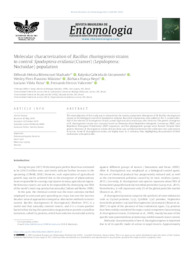Molecular characterization of Bacillus thuringiensis strains to control Spodoptera eridania (Cramer) (Lepidoptera: Noctuidae) population.
Molecular characterization of Bacillus thuringiensis strains to control Spodoptera eridania (Cramer) (Lepidoptera: Noctuidae) population.
Author(s): MACHADO, D. H. B.; LIVRAMENTO, K. G. do; MAXIMO, W. P. F.; NEGRI, B. F.; PAIVA, L. V.; VALICENTE, F. H.
Summary: The main objective of this study was to characterize the toxicity and genetic divergence of 18 Bacillus thuringiensis strains in the biological control of Spodoptera eridania . Bacterial suspensions were added to the S. eridania diet. Half of the selected B. thuringiensis strains caused high mortality seven days after infection. The genetic divergence of B. thuringiensis strains was assessed based on Enterobacterial Repetitive Intergenic Consensus (ERIC) and Repetitive Extragenic Palindromic (REP) sequences, and five phylogenetic groups were formed. Despite their genetic diversity B. thuringiensis strains did not show any correlation between the collection sites and toxicity to larvae. Some B. thuringiensis strains are highly toxic to S. eridania, thus highlighting the potential of their endotoxins as biopesticides.
Publication year: 2020
Types of publication: Journal article
Unit: Embrapa Maize & Sorghum
Keywords: Bactéria, Controle Biológico, Inseto, Praga de Planta, Tipagem molecular, Toxicidade
Observation
Some of Embrapa's publications are published as ePub files. To read them, use or download one of the following free software options to your computer or mobile device. Android: Google Play Books; IOS: iBooks; Windows and Linux: Calibre.
Access other publications
Access the Agricultural Research Database (BDPA) to consult Embrapa's full library collection and records.
Visit Embrapa Bookstore to purchase books and other publications sold by Embrapa.

